Fishing in Florida
 How Much Fun Can You Have Fishing in Florida?
How Much Fun Can You Have Fishing in Florida?
Boaters and fisherman around the world come to the State of Florida to enjoy the nonstop action of our excellent fishing grounds. Florida calls itself "The Fishing Capital of the World", we guess the consensus is we have the best fishing anywhere. Whether you choose to fish on land, a bridge, a pier or by boat, the fishing is can be fast and furious. Our waters, both freshwater and saltwater, are chock full of fish. And our state is Very Fishing Friendly.
Don't overlook obvious fishing spots as you drive around, if it has water it probably has fish. There are canals along most major roadways, both saltwater and freshwater, and you will see people fishing these canals every day. And don't overlook bridges - if there is no sign that say you cannot fish, that means you can whicp out your rod and fish away. If there is a safe place to pull off the road, stop and give it a try.
Vacation Fishing
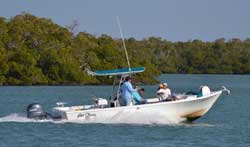 If you're like most anglers who visit Florida you probably want to try out some of the legendary fishing that put the Sunshine State on the charts! Key West captain Craig Eubank offers some tips for tourists who want to fish the Florida waters while visiting.
If you're like most anglers who visit Florida you probably want to try out some of the legendary fishing that put the Sunshine State on the charts! Key West captain Craig Eubank offers some tips for tourists who want to fish the Florida waters while visiting. ![]() Florida Fishing Vacation Tips for Tourists Bridges and fishing piers are great places to go on vacation and great for introducing the kids to saltwater angling. Deep sea and flats charters take planing and can be costly but they offer an education on how to catch local fish and can be relaxing on your vacation.
Florida Fishing Vacation Tips for Tourists Bridges and fishing piers are great places to go on vacation and great for introducing the kids to saltwater angling. Deep sea and flats charters take planing and can be costly but they offer an education on how to catch local fish and can be relaxing on your vacation.
The Most Common Fish We Catch in Florida
| Inshore - flats | Reef - Wreck - Bottom | Offshore deep sea |
| Bonefish | Amberjack | Dolphin |
| Permit | Barracuda | Kingfish |
| Redfish | Cobia | Marlin |
| Sheepshead | Grouper | Sailfin |
| Snapper | Shark | Sharks |
| Snook | Snapper | Swordfish |
| Spotted Sea Trout | Tuna | |
| Tarpon | Wahoo |
Best Months to Catch Saltwater Fish
We have an abundance of saltwater species year round and some that are seasonal. Jump to our Fish Species Seasonal Calendar for details on what fish are in the which region by month.
Where to "Go Fishing" in Florida
Your choices for fishing in Florida are vast and very different depending on where you fish. First off, will you be fishing The Gulf of Mexico, The Florida Keys, or the Atlantic Ocean? Will you be fishing from shore or using a boat to fish from? If you are fishing from a boat will you be fishing inshore or offshore? All fishing area's require different tools and techniques to be successful and offer a variety of different fish. The further out you go the bigger the fish get. Seasons, weather, and tides also dictate what fish are available.
"So Many Options, Not Enough Time" is what anglers constantly say in Florida.
 |
| Photo Courtesy of MBARA |
Blue Water Fishing
Blue Water Fishing refers to fishing way offshore close to the Continental Shelf in both the Gulf of Mexico, The Keys, and the Atlantic Ocean. In the Gulf of Mexico you have to go 100 miles or more to get to the edge of the shelf, but in The Keys and along the Atlantic Coast you don't have to travel far to find the edge of the abyss. This is where you catch huge fish and you need a big boat to get here. Heavy tackle is necessary and lots of bait and chum to draw in schools of large fish. Finding floating debris and sea grass is always an indiction of a good place to fish. Visit our Offshore Fishing page for details on where to Blue Water fish in Florida.
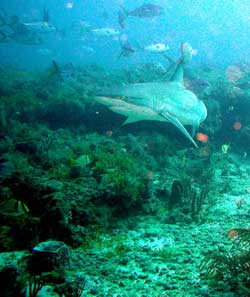
Natural Reefs
Natural Reefs and ledges flank the 120 miles of the Florida Keys, Key Biscayne, and half way up the Florida Atlantic Coast crating the second largest reef system in the world behind the Great Barrier Reef. You can fish the shallow inshore patch reefs for Yellowtail Snapper, Mutton Snapper, Grey Snapper, a variety of Grouper, Hog Fish, Mackerel or Kingfish. Further out to depths of 150 feet are larger reef systems with reliefs of 40 plus feet with large caves, ledges, and natural holes providing breeding grounds and shelter for larger fish species.
Remember, never anchor directly on a reef and if there are mooring buoys available, use them because anchoring is frowned upon in these areas to protect the delicate reefs. Visit our page GPS Coordinates for the numbers of Natural Reefs and Bars around Florida. Visit our Fishing Reefs page for more on Florida reefs.
Shipwrecks & Artificial Reefs
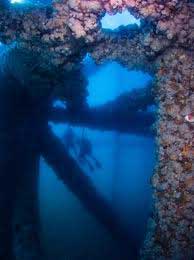 There are more shipwrecks in Florida than anywhere else in the world. Shipwrecks are everywhere on both coasts, both inshore and offshore, so finding one to fish is not hard, you just need the GPS numbers to find them! The Gulf Stream has been for centuries a main shipping channel and many a ship has found misfortune by running aground on reefs or getting caught in hurricanes. Treasures from ships that are hundreds of years old are still being recovered today.
There are more shipwrecks in Florida than anywhere else in the world. Shipwrecks are everywhere on both coasts, both inshore and offshore, so finding one to fish is not hard, you just need the GPS numbers to find them! The Gulf Stream has been for centuries a main shipping channel and many a ship has found misfortune by running aground on reefs or getting caught in hurricanes. Treasures from ships that are hundreds of years old are still being recovered today.
Shipwrecks as we refer to them include intentionally laid wrecks for artificial reefs. Wrecks are not only ships but include submarines, tanks, busses, airplanes, mixing trucks, cargo containers, train cars, or any other large vehicle that would make a good artificial reef. Visit our Reefs page for more info. Visit our page GPS Coordinates for the numbers of Shipwrecks and Artificial Reefs.
Large holes or openings in shipwrecks provide homes to many species of fish and breeding grounds. Larger fish swim through shipwrecks in search for food. Fish use the ships for breeding and shelter. Common species caught on shipwrecks include Snapper, Grouper, Mackerel, Hog Fish, Kingfish, Cobia, Shark, and Barracuda.
Islands
 There are 1,700 islands within the island chain of the Florida Keys and mangrove islands flank both of Florida coasts, most of which are only accessible by boat. Many barrier islands have interesting sights to see such as abandoned structures that mother nature took from man. See our Cape Romano: Where Not to Build an Island Home for some interesting details.
There are 1,700 islands within the island chain of the Florida Keys and mangrove islands flank both of Florida coasts, most of which are only accessible by boat. Many barrier islands have interesting sights to see such as abandoned structures that mother nature took from man. See our Cape Romano: Where Not to Build an Island Home for some interesting details.
Fishing around barrier islands brings fast and furious action if you time your trip to the tides. Knowing the habitat and behavior of the species you will be targeting helps to identify where you should fish around islands. Decisions such as the tides movement, weather, water temperature, and moon phase are all part of the science of fishing. The science of fishing has no hard facts but as you seasoned anglers know, there is a lot of analysis involved in order to decide where and when to cast our line.
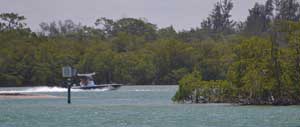 So, when fishing around barrier or mangrove islands, you need to decide if you will fish the pass leading to the island, a point on the island, cast to shore, or beach your boat and fish from land. Are there any deep holes close to shore? Any natural structures like mangrove roots close to shore providing shelter for fish to hole up in during tide changes or to ambush dinner that flows in the tide? Knowing how the species you are targeting reacts to the tides and where they hold up will tell you where to anchor, drop your chum slick, and cast your bait. Visit our page GPS Coordinates for the numbers of popular Islands to fish.
So, when fishing around barrier or mangrove islands, you need to decide if you will fish the pass leading to the island, a point on the island, cast to shore, or beach your boat and fish from land. Are there any deep holes close to shore? Any natural structures like mangrove roots close to shore providing shelter for fish to hole up in during tide changes or to ambush dinner that flows in the tide? Knowing how the species you are targeting reacts to the tides and where they hold up will tell you where to anchor, drop your chum slick, and cast your bait. Visit our page GPS Coordinates for the numbers of popular Islands to fish.
Seagrass Beds
 Seagrass Beds are located throughout Florida in bays and lagoons and along the continental shelf in the Gulf of Mexico. These fragile environments provide food, shelter, and a nursery for many marine species. Larger species visit the seagrass bed to feed on the smaller fishes and crustaceans that inhabit these areas.
Seagrass Beds are located throughout Florida in bays and lagoons and along the continental shelf in the Gulf of Mexico. These fragile environments provide food, shelter, and a nursery for many marine species. Larger species visit the seagrass bed to feed on the smaller fishes and crustaceans that inhabit these areas.
Grouper are commonly found feeding on seagrass beds offshore, so when you encounter a large fish below on your fish finder, you may be over a seagrass bed.
Inshore you can gather bait such as shrimp, crabs, and small fishes on seagrass beds along with fishing for larger species. A common practice is to pole or use a trolling motor over inshore and backwater seagrass beds, this not only protects the fragile beds but also increases your chances for catching fish easily spooked like Bonefish or Snook.Learn about Sea Grasses at FWC
Piers, Bridges & Roadside Fishing
Monroe County provides shore anglers access to fishing on the sides of bridges and roadside throughout the Fishing Friendly Keys. Most of these fishing areas include free parking and access to the water, some even have rest rooms.
The deeper the water you are casting into, the larger the fish. So when fishing bridges, piers, or roadside consider the depth and current when choosing your tackle and bait. Chumming can bring larger fish close to shore and improve your catch since most fish close to shore are undersized and not keepers. It's always a good idea to carry a Florida Fishing Chart with current size and take limits, a ruler, and most importantly your fishing license.
 The Florida Keys Bridges
The Florida Keys Bridges
There are 42 bridges connecting the island chain of the Florida Keys with 7-Mile Bridge being the largest at 35,716 feet long and the shortest Harris Gap at only 37 feet long. There are dozens of old bridges no longer in use converted to fishing piers throughout the Keys. The most famous bridge to fish in Florida is the old Seven Mile Bridge which connects Marathon to Little Duck Key in the Lower Keys. When completed in 1912 by Henry Flagler it was one of the longest bridges in the world. The original bridge was replaced in 1982 with a new modern bridge. The old bridge's center span was removed and fishing piers were created on each end. This bridge is very high off the water with large fish trans versing the open waters below between the Atlantic Ocean and Florida Bay. This is one place to catch large Tarpon and Shark from land, so be sure to use heavy tackle when fishing this bridge if you want to land a big fish. Other great bridges to fish in The Keys are the Long Key Bridge which is 2 1/2 miles long, Toms Harbor, Channel 2 and Channel 5.
If fishing bridges from a boat, anchor up current of the bridge, set your chum line, and cast to the bridge pilings for some great action.
 Tides and wind play a very important factor in your success while fishing near bridges. When the tide is outgoing from Florida Bay to the Atlantic Ocean, bait will flow out of the Bay and fish come in from the ocean to feed. Shrimp, crabs and mullet get carried under the bridges and gravitate to pilings which in turn attracts tarpon, snook, permit, snapper and other species. Quarter-moon tides are best for fishing the shores because the currents are not too strong. Full or new moon tides cause the current to rip through the bridge pilings and makes fishing difficult. If the winds are also blowing out of the north or west then the water gets cloudy and the current gets pushed harder causing terrible fishing.
Tides and wind play a very important factor in your success while fishing near bridges. When the tide is outgoing from Florida Bay to the Atlantic Ocean, bait will flow out of the Bay and fish come in from the ocean to feed. Shrimp, crabs and mullet get carried under the bridges and gravitate to pilings which in turn attracts tarpon, snook, permit, snapper and other species. Quarter-moon tides are best for fishing the shores because the currents are not too strong. Full or new moon tides cause the current to rip through the bridge pilings and makes fishing difficult. If the winds are also blowing out of the north or west then the water gets cloudy and the current gets pushed harder causing terrible fishing.
Beaches and Jetties

Fishing on Florida beaches is a popular sport around the state. I don't know of any beaches that do not allow fishing, so bring your gear the next time you have to bring the family to the beach. Fishing and Beach Carts are a common sight on our beaches and make a great ready-to-go fishing accessory.
Most anglers buy live shrimp at a bait shop or use frozen squid as bait for beach fishing. But locals prefer to cast net for small bait fish that are plentiful at the shore. Another popular activity is to dig for sand fleas which make excellent bait.
On the Atlantic coast and northern Gulf beaches you will find anglers on the beach with large surf casting setups. The surf is stronger in these areas so larger rods get your bait out to where the fish are.
Fly fishing on the beach is very common and the beach is a great place to learn both fly fishing and cast netting, you have plenty of space to throw on our spacious beaches.
Jetties are all over Florida and especially at the entrance to channels. These large rock structures hold bait fish that in turn attract larger fish trans versing the channels with the tides. Many jetties off fishing areas where you can fish from land; others you have to get your feet wet and wade into the water to cast into the rocks. Visit our Shore and Beach Fishing page for more info.
Florida Bay
 Florida Bay is a large area, called Bay Side by the locals, sandwiched between the tip of the Florida Peninsula and The Florida Keys. Within the bay is an estuary of hundreds of mangrove islands surrounded by salt and brackish water flowing in from the Everglades. Average depth is about 3 feet with some deeper holes dropping to 9 feet, so this is a flats boat, small boat only fishing area. Using a push pole and trolling motor is common boat accessories when fishing the bay. Since the water is so shallow, sight fishing is very exciting here.
Florida Bay is a large area, called Bay Side by the locals, sandwiched between the tip of the Florida Peninsula and The Florida Keys. Within the bay is an estuary of hundreds of mangrove islands surrounded by salt and brackish water flowing in from the Everglades. Average depth is about 3 feet with some deeper holes dropping to 9 feet, so this is a flats boat, small boat only fishing area. Using a push pole and trolling motor is common boat accessories when fishing the bay. Since the water is so shallow, sight fishing is very exciting here.
There are hundreds of mangrove islands, some with sandy white beaches, along with grassy flats which provide shelter and nursery grounds for a large number of fish. You can fish for Tarpon, Bonefish, Permit, Snapper, Redfish, Shark, Snook, and dozens of other species. Bait is plentiful in Florida Bay and easily caught with cast nets.
When venturing out on Florida Bay in a boat be sure to have a GPS unit, area nautical chart, and a VHF unit on board. It is easy to get lost among the mangrove islands, they all look alike. Also make note of the tides so you don't get stranded in the shallow waters. See our Boat Launch Sites page for places to put your boat in. Click the above image of Florida Bay to view the Florida Bay Map and Guide.
Indian River Lagoon
The Indian River Lagoon is part of one of the longest barrier island estuaries in the United States. This 156 mile long body of water separated from the Atlantic Ocean by barrier islands starts at the Ponce de Leon Inlet in the Mosquito Lagoon and ends at the Jupiter Inlet near West Palm Beach. This body of water that contains both salt and brackish waters with both temperate and tropical species that coexist and thrive. Five counties border the lagoon and it has three distinct areas: Mosquito Lagoon is the northern most section in Volusia County, Banana River is in Brevard County, and the southern section the Indian River Lagoon which starts in Brevard County and ends in Martin County.
Fishing the lagoons is limitless, from fishing by boat, shore, piers, beaches, kayaks you can fish open waters, inlets, oyster and clam beds, sea grass areas, and barrier islands. Tarpon, Snook, Redfish, and Sea Trout are abundant along with dozens of other species.
Freshwater
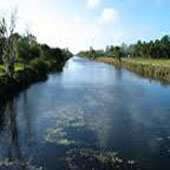 Florida has thousands of lakes, rivers, and probably a million miles of canals to fish for freshwater species. The lower half of the Florida Peninsula is within the boundaries of what is called The Everglades which is one huge freshwater river flowing from Orlando into Florida Bay.
Florida has thousands of lakes, rivers, and probably a million miles of canals to fish for freshwater species. The lower half of the Florida Peninsula is within the boundaries of what is called The Everglades which is one huge freshwater river flowing from Orlando into Florida Bay.
Lake Okeechobee is our largest lake and is the host to major Bass fishing tournaments annually. You don't have to go far to find great freshwater fishing for Bass, Crappies, big Catfish around Florida.
View a list of the top freshwater fishing locations in Florida ![]() Freshwater Locations Florida.
Freshwater Locations Florida.
Before You "Go Fishing"
Because we have so many out of town visitors fishing our waters, we offer the following advise to help ensure you have a great fishing day. Creating good angler habits when preparing for fishing trip will ensure a fun fishing day. Before you wet your fishing line in Florida, you should familiarize yourself with our rules & regulations for a safe trip. See our Fishing Regulations page for more details.
If you will be fishing from a boat please review Florida's Boating Regulations. We have lots of information on Boating on this website so jump to our Boating page for more details.
Here is a quick list of actions your should take before you go fishing: 
- Review the Chart or Map of the area you will be visiting
- Check the local Tide Chart-tides have a profound effect on where the fish are located
- Check the Weather forecast, don't get caught unprepared
- Bring a cell phone or portable VHF
- Be sure you have proper identification for everyone and
a fishing license for each angler - Bring ample food and especially extra fresh water
- Bring extra clothing and foul weather gear
Tides
 Knowing the tides increases your chances of fishing success as many species react to the moving tides. Florida tides run an average of 4 feet from high to low tide. It is also important to check the tides before you go boating to avoid groundings.
Knowing the tides increases your chances of fishing success as many species react to the moving tides. Florida tides run an average of 4 feet from high to low tide. It is also important to check the tides before you go boating to avoid groundings.
We give you tips and advise as to where to find fish during tide changes throughout this website, so explore and learn. Florida tides vary by location, so check our Tides & Charts page for more information and clickable charts.
Tides and Fishing
Planing your fishing around the tides can make a big difference! Tides, currents, wind, moon phase, and the weather all effect the movement of fish, their feed patterns, and whether you have fast furious action or not one bite. 
- Outgoing - fish leave low lying bays for deeper water
- Low - fish hold up in deeper water
- Incoming - fish travel back to bays and estuaries
- High - fish enjoy deep bays and estuaries
Wind can have a very profound effect on tides. If there is a sustained wind 10 knots for several hours, it can cause the mean low or high tide to be off by a foot or more. As an example, if the wind is blowing 10 knots from the north and the tide is incoming, the returning incoming tide can not fill the bays because it is blocked by a wall of wind. In the same conditions, an outgoing tide would get pushed out faster and cause the same bay to empty out a foot lower than normal.
Moon tides also effect the tide levels and are predictable. All tide charts show the level from mean tide as +/- in feet. During moon tides the water levels can be extreme from low to high tide. Fish respond to the moon pull just like they say humans do - anyone howl at the moon lately? The tides tend to be flowing faster, stronger currents, causing fish to react to the action of the currents. Bait flow freely with the tides, but during moon tides they fly along with the current causing the bigger fish to hold out behind structure to ambush the bait. It is not easy to hold still during a strong current, so the fish tend to congregate in calmer spots waiting for their dinner to flow by.
Weather also effects fishing. If the water temperatures are too high, the fish will seek cooler holes. During winter, deeper holes are warmer than the surface, so popular fish like Snook that cannot tolerate cold water seek warmth in back waters or deep holes.
The best time to fish is when there is moving water during either incoming rising tides or outgoing low tides. The incoming tides are always the best because the rising water fills feeding areas by freeing from the bottom marine life that holed up after the outgoing tide. This marine life feeds bait fish which in turn attracts the big ones.
The worst time to fish is when there is no water movement during slack tides. Slack periods can occur for several minutes to as much as nine or 10 hours. During slack periods fish stop feeding because there are no currents that transport schools of bait within range of the game fish. During slack periods a lot what fish feed on burrow into the the bottom or move into the grass in marshes.
Maps & Nautical Charts
Boaters, you should use a GPS, compass, and/or have area nautical maps onboard, especially if you are not familiar with the local waters. Most inland waterways around Florida can be shallow, so knowing your depth is very important to avoid grounding. Staying within nautical markers is encouraged to protect both wildlife and our waterways, and to keep you from getting lost in the back waters. It is also very easy to get lost in mangrove islands, so use your charts! See our Charts page for more information.
Prepare for Extreme Weather, Hazards, and Emergencies
Don't be disillusioned by our beautiful weather. Weather fronts can come upon you quickly and without much warning. Because of our shallow waters, incoming fronts can transform a quiet bay into a choppy dangerous waterway in a matter of minutes. Thunder storms are especially dangerous on the water and be down right scarey in Florida. Consider scheduling your trip to avoid storms.
Keeping your marine radio set to NOAA's Marine Radio VHF channel 13, especially during the summer months. Watch the sky for dark cloud massed approaching. If you see a distant storm, consider the direction of the wind to help you judge where the storm is going. If a storm is coming your way, seek cover immediately. Jump to our Weather page for more informations. Also visit our Hazards to Avoid page for more on weather and other hazards to avoid.
Angler's Code of Ethics
NOAA NMFS adopted an Angler's Code of Ethics, which encourages anglers to:
- Promote, through education and practice, ethical behavior in the use of aquatic resources;
- Value and respect the aquatic environment and all living things in it;
- Avoid spilling and never dump any pollutants, such as gasoline and oil, into the aquatic environment;
- Dispose of all trash, including worn lines, leaders and hooks, in appropriate containers, and help keep fishing sites litter-free;
- Take all precautionary measures necessary to prevent the spread of exotic plants and animals, including live baitfish, into non-native habitats;
- Learn and obey angling and boating regulations, and treat other anglers, boaters and property owners with courtesy and respect;
- Respect property rights, and never trespass on private lands or waters;
- Keep no more fish than needed for consumption, and never wastefully discard fish that are retained;
- Practice conservation by carefully handling and releasing alive all fish that are unwanted or prohibited by regulation, as well as other animals that may become hooked or entangled accidentally;
- Use tackle and techniques that minimize harm to fish when engaging in "catch and release" angling. This code of ethics could easily be modified.
Leave No Trace Practices
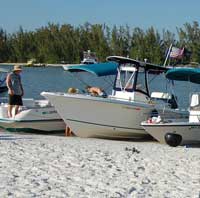 In order to keep our waterways and beaches pristine, always follow "Leave No Trace" practices. This involves everyone's conscious effort to keep our county in pristine condition and our wildlife safe.
In order to keep our waterways and beaches pristine, always follow "Leave No Trace" practices. This involves everyone's conscious effort to keep our county in pristine condition and our wildlife safe.
When boating, do not throw anything overboard. If you see trash in the water or you accidently drop something into the water, please retrieve it. Trash in our waterways endangers aquatic life and pollutes the waters. There are hefty fines for littering, so don't do it.
For more information visit our Leave No Trace page.
Hook-and-Line Gear
 Hook-and-line anglers must practice Leave No Trace procedures with their fishing hooks and lines to protect wildlife. Always" mind your line".
Hook-and-line anglers must practice Leave No Trace procedures with their fishing hooks and lines to protect wildlife. Always" mind your line".
It is against the law to intentionally discard any monofilament netting or line into or onto state waters. Monofilament line can entangle birds, marine mammals, marine turtles and fish, often injuring or killing them. At most public fishing areas you will find Fishing Line disposal containers, please use them.
The Monofilament Recovery & Recycling Program (MRRP) is a statewide effort to educate the public on the problems caused by monofilament line left in the environment, to encourage recycling through a network of line recycling bins and drop-off locations, and to conduct volunteer monofilament line cleanup events.
For more information see http://www.fishinglinerecycling.org. ![]() Recycle centers located around the state.
Recycle centers located around the state.
Catch and Release
Freshwater anglers are encouraged to practice Catch and Release to preserve our freshwater populations. For information see our Catch & Release page.
Special Fishing Rules for Vessels
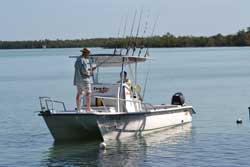 Fishing in Florida can be a very rewarding experience. Locals know the rules well and follow them because law enforcement is very strict and always watching you. See our Fishing Regulations page for more details. Here are a few important rules to know when fishing on your boat.
Fishing in Florida can be a very rewarding experience. Locals know the rules well and follow them because law enforcement is very strict and always watching you. See our Fishing Regulations page for more details. Here are a few important rules to know when fishing on your boat.
Each person on board a vessel who is fishing must have a fishing license unless they are on a fishing charter or Exempt.
Your catch must remain in whole condition until landed ashore (heads, fins & tails intact). Please refer to the Florida Saltwater Regulations guide for the specifics on each species.
Always know what your fish is and the rules that apply to it before keeping it. You should also refer to the list of Prohibited Species before fishing.
Do NOT bring tarpon or Goliath grouper on board your boat. New state and federal guidelines PROHIBIT this activity. Release them while still in the water.
All vessels fishing in federal waters (9 miles on the Gulf, 3 miles Atlantic & Keys) must have aboard venting and dehooking tools and non-stainless steel circle hooks when using natural baits for the purpose of reducing mortality in reef fishes, including Snapper and Goliath Grouper. For information on these tools, see our Catch & Release page.
Regulations
We don't mean to be stuffy, but in order to ensure our waters remain safe and enjoyable, know Florida boating and fishing regulations before you venture out. The information provided on Florida Go Fishing will give you an overview of our regulations. See Boating Regulations and Fishing Regulations.
![]() You must at all times carry your fishing license when fishing except on public piers where it is posted you do not need one.
You must at all times carry your fishing license when fishing except on public piers where it is posted you do not need one.
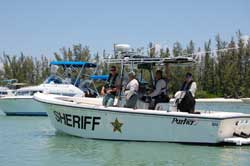 Marine law enforcement from several agencies are active on our waters and will periodically ask for to see your fishing license or pull you over and perform a safety inspection of your watercraft. To avoid unnecessary delays and fines, read up on our rules, follow posted speed zones, stay out of restricted areas, follow the regulations, and keep your boat in excellent condition.
Marine law enforcement from several agencies are active on our waters and will periodically ask for to see your fishing license or pull you over and perform a safety inspection of your watercraft. To avoid unnecessary delays and fines, read up on our rules, follow posted speed zones, stay out of restricted areas, follow the regulations, and keep your boat in excellent condition.









